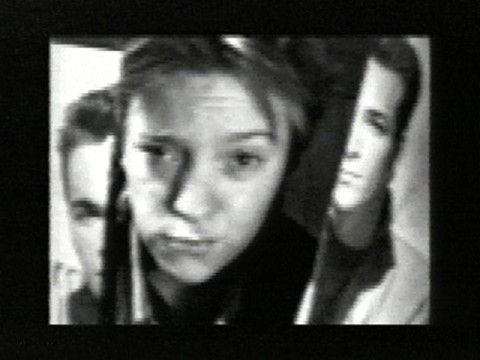Sadie Benning’s career in video began under less than ideal circumstances, in fact, quite traumatic ones. On New Year’s Eve 1988, her friend was hit by a car and there was a shooting in her neighborhood. Benning began to spend a lot of time alone in her bedroom, but wanted to talk to someone. So, she spoke to her toy Pixel Vision video camera, a gift from her father, the experimental filmmaker James Benning. As she recalls, Benning liked that the camera “wouldn’t talk back to me or judge me.”
Through her filmmaking in the safety of her bedroom, Benning would narrate her thoughts and reflect on the challenges of growing up, particularly as they relate to gender and sexual identity. She realized her identity as a lesbian. Now considered gender fluid, Benning has expanded her practice to include a range of media, such as sound, painting, drawing, photography, and found objects.
Born 1973 in Madison, Wisconsin, Benning was raised by her mother in Milwaukee and now lives and works in New York City. She has had a successful career since 1993, when she became the youngest artist ever featured in the Whitney Biennial at age nineteen. Since then she has had solo exhibitions at the Wexner Center for the Arts (2004), Walker Art Center (2005), Dia Foundation for the Arts (2007), Whitney Museum of American Art (2009), and Renaissance Society (2016). At age forty, she entered the MFA program at Bard College, where she has been a faculty member, and graduated in 2015.
In Benning’s pixel-vision works of the 1990s, we observe extreme close-ups of Benning’s face as she speaks to her “camera diary.” The immediacy of her presence underscores a range of urgent themes she explores through voiced ruminations placed within montages of photographs, home movies, tv and film clips, and text written on paper. In A Place Called Lovely (1991), Benning references various forms of violence, both physical and emotional. Through the story of a love affair with a “bad girl,” she examines gendered stereotypes popularized by Hollywood in It Wasn’t Love (1992). As Benning has stated, “the images she saw on television and in movies are “totally fake…I got started partly because I needed different images and I never wanted to wait for someone to do it for me.”
Benning also has created experimental, live-action cartoons for Flat is Beautiful (1998), a narrative about the loneliness of an androgynous eleven-year-old girl. She used puppetry to illustrate the story of a teenage girl named Judy who “seems to experience the world from the outside, letting things happen to her” in Judy Spots (1995). And in 1998, Benning co-founded Le Tigre, a feminist post-punk bad with singer/guitarist Kathleen Hanna (formerly of Bikini Kill) and zinester Johanna Fateman.
Recent works have contemplated how God is imagined. In particular, Benning has wrestled with the meaning of the biblical passage Genesis 1:27, which states, “So God created mankind in his own image, in the image of God he created them; male and female he created them.” In a 2016 exhibition at Mary Boone Gallery, Benning gave form to several types of gods—toys, idols, animals, and sports heroes—in works that incorporate found objects and photographs into the compositions. She also has meditated on the way in which we internalize structures of capitalism, racism, patriarchy, and xenophobia in an installation mounted at Kunsthalle Basel in 2017. There she created a sculptural wall work of mixed-media panels that juxtaposed various images from digital snapshots, found photographs, and painted elements.
Girl Power (1992) shows Benning’s aim to reach a wider audience with her video works. Informed by the “riot grrl” movement of the 1990s, an aggressive underground movement led by young women who espoused female empowerment through art, music, zines, and activism. Girl Power is a collage of sound and black-and-white imagery. The work refuses to visualize female passivity and politeness in favor of a range of views of radicality and rebellion in an amalgam of footage from TV, film, commercials, security cameras, and home movies as well as disturbing scenes of racial violence and homophobic speeches.
The soundtrack is a range of musical styles and includes excerpts of songs by Sugar Hill Gang, Blondie, Grace Jones, and Nina Simone; however, the main soundtrack is supplied by the band Bikini Kill, largely seen as founders of the “riot grrl” movement. Their music accompanies several voice-overs by Benning and reinforces a sense of insistence in her narrative. Benning recounts how she could not escape the real world, so she created her own world in her mind, which she details. Evident throughout this video and indeed Benning’s career is a powerful sense of her resilience and self-determination. Benning’s art in many ways reflects her approach to life stated near the end of Girl Power: “I survived because I created my own heroes.” –Kanitra Fletcher

